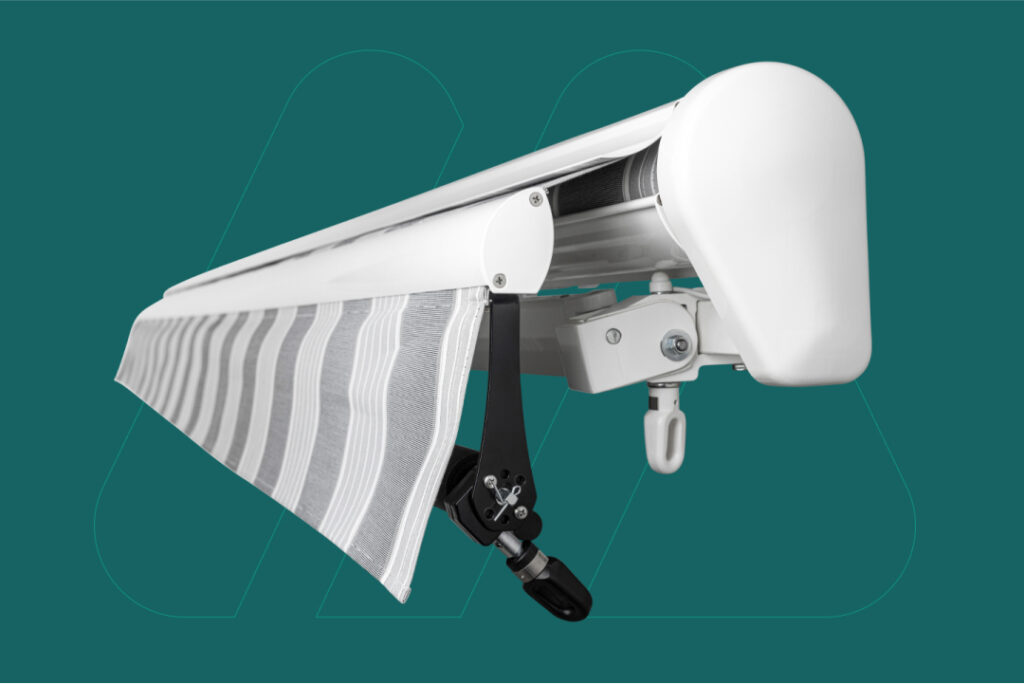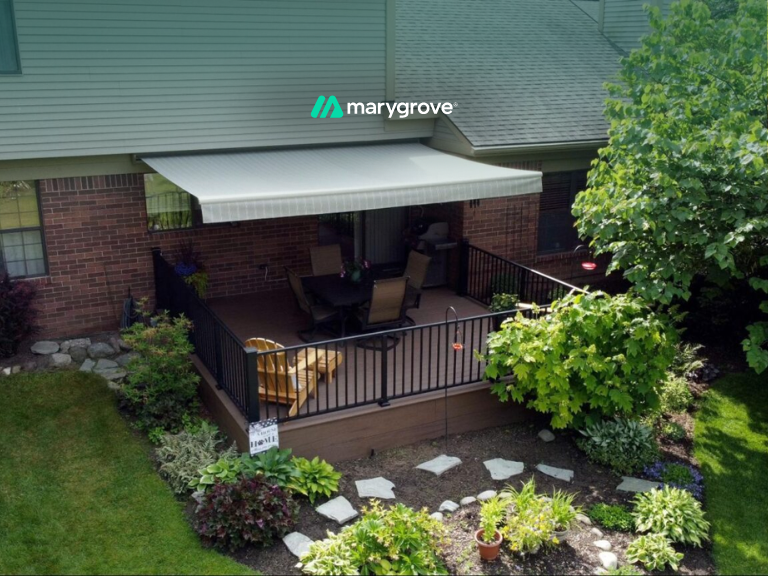To keep birds out of retractable awnings, block access with netting or full-cassette models, use daily motion, and remove attractants like feeders or nests. Smart movement and physical barriers are key.
Stop Birds from Nesting in Your Awning Today
Birds love awnings because they’re quiet, covered, and rarely disturbed. But what starts as a harmless perch can turn into acidic droppings, jammed arms, mildew, and even health risks for your family or pets.
To stop birds from nesting in your awning, use a combination of movement, physical barriers, and habitat disruption:
- Open your awning daily in spring to signal activity
- Remove nearby feeders and clean droppings regularly
- Block access points with PVC pipe or side screens
- Install spikes, ¾” netting, or a wire maze under the frame
- Use decoys and reflective tape, but rotate them weekly
- Avoid harsh sprays or DIY kits that damage fabric or void warranties
- Upgrade to a full-cassette awning that seals completely when closed
Every step reduces a bird’s incentive to stay, and when combined, these methods can end the cycle entirely.
You’ll find practical fixes and smarter solutions below, especially if you’ve tried everything and birds still keep coming back.
How Birds Interact with Retractable Awnings and the Problems They Cause

Birds are naturally drawn to the shelter and warmth that retractable awnings provide.
When left unused, especially during early spring, awnings offer an undisturbed space that mimics natural nesting spots.
Unfortunately, once birds move in, they rarely leave quietly. Here’s what makes this such a problem:
- Common nesters include sparrows, pigeons, and starlings, highly adaptive birds known to return to the same spot each year.
- Droppings are acidic, damaging fabric and corroding metal parts over time.
- Nesting material can clog drainage paths or jam the retracting mechanism, especially in motorized awnings.
- Health risks like mites, bacteria, and fungal spores can spread from bird waste, posing a danger to pets and family members.
- Persistent nesting behavior can be incredibly frustrating. As one customer put it: “I cleaned it daily and they still came back.”
Understanding why birds choose your awning is the first step toward preventing them from turning it into a seasonal home.
Next up: how to keep them out, for good.
The Ultimate Bird-Proofing Checklist for Your Awning
If you want to reclaim your outdoor space, here’s a complete list of proven methods to keep birds away, starting today.
From simple daily habits to tech-enabled solutions, every tip below helps you stay one step ahead of nesting season.
Start with prevention before nesting begins:
The easiest wins come from stopping the problem before it starts. These small changes create an environment that tells birds: this place is off-limits.
- Daily awning extension: Open and close your awning every day during nesting season to signal that the space is active, not abandoned.
- Remove nearby bird feeders and baths: Keep feeders, water bowls, or birdhouses away from your awning area to reduce local bird traffic.
- Clean droppings quickly: Droppings act like scent trails. Clean them regularly to stop birds from returning to “marked” territory.
Just a little effort early in the season can save you weeks of cleaning and frustration later.
Block off access to popular nesting zones:

Birds are opportunistic, they’ll squeeze into any small ledge, gap, or corner that gives them cover. These steps focus on sealing off their favorite entry points.
- Install a PVC pipe: Place a 1.5” PVC pipe along the mounting bar to seal off common nesting gaps, easy, discreet, and effective.
- Switch to a full-cassette awning: Models like Marygrove’s fully enclose the arms and fabric when retracted, eliminating nesting ledges altogether.
- Add side screens: Custom-fit side screens from Marygrove help block wind gaps and lateral entry points birds love to sneak through.
Once these zones are sealed, most birds will simply move on to an easier target.
Use physical deterrents that actually work:
If birds are still showing up, it’s time to get hands-on. These tools physically prevent them from landing, settling, or nesting under your awning.
- Apply bird spikes: Humane acrylic bird spikes on flat surfaces prevent perching and nesting without harming birds.
- Install ¾” bird netting: Stretch mesh under the awning to deny access entirely, especially effective for active nesting spots.
- Create a wire mesh maze: Tensioned wire patterns beneath the awning are subtle to the eye but confusing and discouraging to birds.
These deterrents work best when placed where birds land or linger, especially in spring and early summer.
Scare them off using visual or motion-based deterrents:
Birds spook easily. If you can make your awning look risky or unpredictable, they’ll usually steer clear.
- Hang reflective deterrents: Use shiny tape, old CDs, or mirror discs to flash unpredictable light and frighten birds away.
- Use predator decoys: Owls, snakes, even rubber dinosaurs can work. Just be sure to rotate their location regularly.
- Leverage motion with a smart awning: Marygrove’s app and voice control lets you schedule automatic movement, birds hate unpredictability.
The key here is movement and variety. Change things up often so birds don’t adapt.
Use sensory repellents cautiously:
These options work on birds’ senses, touch, smell, and sound, but should be used with care to avoid damaging your awning or upsetting pets.
- Apply gel repellents (on non-fabric surfaces): Products like SpectrumV make flat landing zones tacky and uncomfortable for birds.
- Hang scented pouches: Grape-scented Avian Block pouches repel birds using smell, just hang them discreetly around your awning area.
- Install ultrasonic repellers: These devices emit bird-disturbing sound frequencies. Just be mindful, they may also bother pets like cats and dogs.
Used in the right spot, these repellents can add a final layer of protection, just always follow product guidelines.
Done right, these strategies can drastically reduce bird activity and protect your awning season after season.
But if the birds still come back, despite your best efforts, it may not be your tactics that need changing. It might be the awning itself.
Helpful Resource → Cleaning Canvas Awnings Without Damage | Pro Guide + Tips
When DIY Isn’t Enough, Signs You Need a Better Awning Setup

Sometimes, no matter how many deterrents you try or how many times you clean, the birds just keep coming back.
That’s when the problem isn’t just about what’s on your awning, it’s about how your awning is built in the first place.
Here are the most common signs that your setup may be working against you:
- Birds keep nesting even after spikes, gel, or decoys. This usually means they’ve found a secure gap or ledge your tools aren’t addressing.
- Stubborn poop stains that won’t come out. Droppings baked in by the sun can permanently damage standard awning fabric.
- Birds sneaking in while the awning is retracted. If the casing leaves gaps or the arms stay partially exposed, it becomes the perfect nesting nook.
A full-cassette awning with sealed housing can eliminate gaps, ledges, and other common nesting zones.
When paired with automated retraction, it creates motion birds can’t predict—making the space less appealing over time.
If DIY fixes haven’t worked, an upgraded system may be the smarter long-term solution.
But even with the right setup, you might still encounter active nests. And before you remove anything, there are a few legal and safety rules you need to know.
Helpful Resource → How to Measure for an Awning (Without Mistakes)
What About Active Nests? Read This Before Removing Them
Before you grab a ladder and gloves, take a moment. Removing an active bird nest isn’t just a messy chore, it could be illegal.
Under the Migratory Bird Treaty Act, many common species like sparrows, finches, and robins are federally protected.
That means you cannot disturb, remove, or destroy active nests (with eggs or chicks inside) during nesting season, typically spring through early summer. Here’s how to handle it based on what you find:
- If the nest is empty or has no eggs:
You’re in the clear. Carefully remove the nest and dispose of it. Then scrub the area with a vinegar-and-water mix or a mild detergent like dish soap to eliminate scent trails. - If the nest contains eggs or chicks:
You must wait. Let the birds finish nesting, this usually takes 2 to 4 weeks. Once they leave, remove the nest, disinfect the area, and seal any gaps to prevent future nesting.
Pro tip: When cleaning bird droppings, use a soft brush, warm water, and either vinegar or a diluted OxiClean solution. Never use harsh chemicals, they can damage your awning’s fabric and harm wildlife.
It’s frustrating to wait, but in the long run, handling nests the right way keeps you on the safe side, legally, ethically, and structurally.
Once the nest is gone, it’s tempting to throw everything at the problem.

But not all bird deterrents are safe for your awning. Some can actually make things worse.
Common Bird Deterrent Mistakes That Could Ruin Your Awning
When it comes to keeping birds away, the wrong solution can cause more harm than good.
Here are the top 5 mistakes homeowners make, and how to avoid them.
1. Spraying Harsh Chemicals Like WD-40
It might seem like a quick fix, but oil-based sprays like WD-40 can stain your awning fabric and degrade the frame over time.
They’re also not safe for birds, pets, or the environment.
2. Using Sharp or Metal Mesh
While bird mesh is effective, using sharp-edged metal can snag or tear the canopy, especially on retractable models where the mesh shifts during movement.
3. Mounting Hardware That Voids the Warranty
Drilling into the awning frame or attaching deterrents in ways not approved by the manufacturer may void your product warranty.
Always check with your provider, Marygrove offers solutions that work without compromising coverage.
4. Leaving the Awning Wet or Extended in Wind
Moisture buildup can attract mildew and insects, while wind-tossed fabric may create cozy corners for nesting.
A wet, idle awning is practically an invitation to birds.
5. Buying Generic Kits Without Support
Many online kits look promising, but lack proper guidance or support, and may not suit retractable awnings.
Worse, they often don’t last beyond one season.
Avoiding these missteps protects your awning’s longevity and ensures your bird-proofing efforts don’t backfire.
A little caution goes a long way when protecting your awning.
By steering clear of these common mistakes, you’ll save yourself costly repairs—and make sure your deterrents work as intended. It’s not just about keeping birds out, it’s about doing it the right way.
Final Thought: The Smartest Long-Term Fix Might Just Be a Smarter Awning
If you’ve tried every trick in the book and birds still keep nesting, it might be time to stop treating the symptoms, and upgrade the system itself.
Marygrove’s retractable awnings are built with bird prevention in mind, not as an afterthought.
The full-cassette design seals away fabric and hardware when retracted, eliminating the ledges and gaps where birds typically nest.
With app and voice-controlled motion, you can schedule daily extensions, even while you’re away, disrupting birds’ routines before they settle in.

If your current awning feels like an open invitation to birds, it may be time to consider a smarter, sealed solution.
Explore custom options or request a free quote to see what’s possible.


